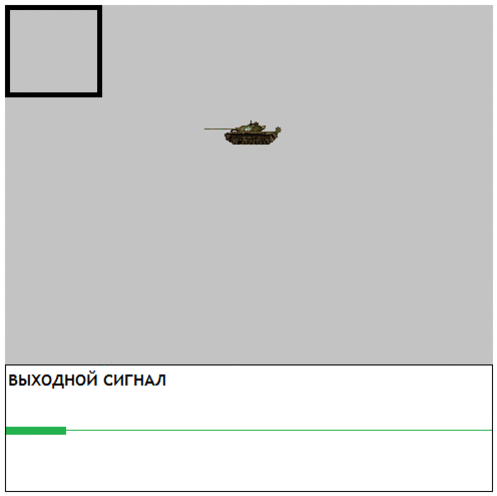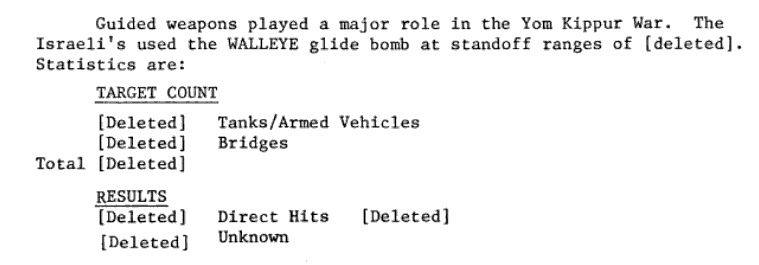You are using an out of date browser. It may not display this or other websites correctly.
You should upgrade or use an alternative browser.
You should upgrade or use an alternative browser.
isayyo2
Lurker alert
- Joined
- 24 November 2011
- Messages
- 1,035
- Reaction score
- 1,876
Essentially a daytime television camera with a crosshair that could be locked onto objects, there's a great China Lake documentary on its development.Does anyone know what principle this 60's bomb worked on?
How could it track moving targets such as tanks in those days?
Unfortunately, but English is not my language and I do not have time to translate and watch this video.Essentially a daytime television camera with a crosshair that could be locked onto objects, there's a great China Lake documentary on its development.Does anyone know what principle this 60's bomb worked on?
How could it track moving targets such as tanks in those days?
At one point I found there that he was following the train from a VERY close distance and that was it.
There was no further mention of moving targets.
Dilandu
I'm dissatisfied, which means, I exist.
Rather simple. The analog TV system worked, by scanning the image line after line. The movement of scanning beam was controlled by very precise electronic timer (the time base). During each scan period, each pixel of the image was scanned at precise time, determined by time base. So the position of each pixel could be easily determined by the time base signal.Does anyone know what principle this 60's bomb worked on?
How could it track moving targets such as tanks in those days?
The "Walleye" seeker was a contrast seeker - which means that it tracked the high-contrast spots that stand out on the background. For example, a dark window on the white building wall. When the scanning beam moved over such contrast spot, there was a sharp jump in the voltage. The small logic circuit reacted on such jump, and stored the corresponding time base signal voltage in its capacitor. So: the circuit "memorized" where the scanning beam was at the moment the signal jumped. I.e. circuit memorized, where in the camera field of view was a contrast spot.
The seeker moved camera in such way, that the contrast spot stay directly in the center of image. The camera was set on the gimball, so it could move independently of the bomb's body. The bomb autopilot them tried to align the longitudal axis of the bomb body with the axis of the camera.

I made this little gif a few years ago to demonstrate, how TV contrast seeker of "Walleye" caught the moment when the output signal jumped.
Dilandu
I'm dissatisfied, which means, I exist.
Do you speak Russian? I have an article about "Walleye" made by me in my LiveJournal:Unfortunately, but English is not my language and I do not have time to translate and watch this video.
https://fonzeppelin.livejournal.com/102550.html
Unfortunately not :/Do you speak Russian? I have an article about "Walleye" made by me in my LiveJournal:Unfortunately, but English is not my language and I do not have time to translate and watch this video.
https://fonzeppelin.livejournal.com/102550.html
Russian equivalent walleye i.e. KAB-500Kr could also track moving targets such as tanks?
Dilandu
I'm dissatisfied, which means, I exist.
Ok, to put it simply - optical contrast seeker track the contrast spot on monotonous background. Like tank on road.Unfortunately not :/
Ok walleye can track moving targets on desert etc.. but on jungle/ green areas?Ok, to put it simply - optical contrast seeker track the contrast spot on monotonous background. Like tank on road.Unfortunately not :/
- Joined
- 16 April 2008
- Messages
- 8,415
- Reaction score
- 10,420
Walleye was not generally used to target small moving targets. It was used mainly against static high-value structures were you could be confident that there would be good contrast, and where you got good value for the money. It was not a cheap weapon -- roughly $35000 in the late 1960s, compared to about $3000 for a Paveway in the same timeframe.
Ok but it doesnt mean that it cant track moving targets like tanks.Walleye was not generally used to target small moving targets. It was used mainly against static high-value structures were you could be confident that there would be good contrast, and where you got good value for the money. It was not a cheap weapon -- roughly $35000 in the late 1960s, compared to about $3000 for a Paveway in the same timeframe.
- Joined
- 16 April 2008
- Messages
- 8,415
- Reaction score
- 10,420
Ok but it doesnt mean that it cant track moving targets like tanks.Walleye was not generally used to target small moving targets. It was used mainly against static high-value structures were you could be confident that there would be good contrast, and where you got good value for the money. It was not a cheap weapon -- roughly $35000 in the late 1960s, compared to about $3000 for a Paveway in the same timeframe.
It was not used like that, in large part because it would not have been very good at it. It needed strong and consistent contrast. A tank driving around would likely have changing contrast as it moved.
In the long video above, you can see a tank used as a target, but it is stationary, not moving.
To the extent that your game is showing Walleye as an anti-tank weapon it is mostly ahistorical.
And can you back up your claims with some evidence?Ok but it doesnt mean that it cant track moving targets like tanks.Walleye was not generally used to target small moving targets. It was used mainly against static high-value structures were you could be confident that there would be good contrast, and where you got good value for the money. It was not a cheap weapon -- roughly $35000 in the late 1960s, compared to about $3000 for a Paveway in the same timeframe.
It was not used like that, in large part because it would not have been very good at it. It needed strong and consistent contrast. A tank driving around would likely have changing contrast as it moved.
In the long video above, you can see a tank used as a target, but it is stationary, not moving.
To the extent that your game is showing Walleye as an anti-tank weapon it is mostly ahistorical.
Such talk without evidence makes no sense.
Here, for example, you have proof of tank tracking.

Flashpoints
From acclaimed aviation historian Michael Napier, this is a highly illustrated survey of the aerial fighting in the flashpoints of the Cold War.The Cold War years were a period of unprecedented peace in Europe, yet they also saw a number of localised but nonetheless very intense wars throughout...
www.google.co.uk

Israeli A-4 Skyhawk Units in Combat
The light and agile A-4 Skyhawk was the first modern American jet to be offered to the Israeli Air Force, marking the point where the US took over from France as Israel's chief military supplier. Deliveries began too late for the A-4 to fight in the Six-Day War, but it soon formed the backbone...
www.google.co.uk

While the numbers are redacted this official US document also confirms Israel used the walleye against tanks:
In addition this official US document lists the Walleye as being suitable to attack mobile targets which "include tanks", while the GBU-15 is listed as suitable for attacking soft mobile targets which "include trucks, vans, and personnel carriers".
- Joined
- 16 April 2008
- Messages
- 8,415
- Reaction score
- 10,420
OK, so that is interesting. I was looking primarily at the USN experience in Vietnam, where moving targets were not a significant part of the Walleye target set.
I do see sources that about 70 tanks were targeted with Walleye during the Yom Kippur war, with a high percentage of hits claimed. So that's a lot more than I expected. However, there are two caveats. First, the Sinai is about the perfect environment for using Walleye this way, with good contrast and not a lot of overhead cover. Second, it's not clear that the targeted tanks were moving. Walleye may well have been used to target tank lagers or other places where tanks were found stationary. We don't know.
I do see sources that about 70 tanks were targeted with Walleye during the Yom Kippur war, with a high percentage of hits claimed. So that's a lot more than I expected. However, there are two caveats. First, the Sinai is about the perfect environment for using Walleye this way, with good contrast and not a lot of overhead cover. Second, it's not clear that the targeted tanks were moving. Walleye may well have been used to target tank lagers or other places where tanks were found stationary. We don't know.
- Joined
- 16 April 2008
- Messages
- 8,415
- Reaction score
- 10,420
So one can assume so. Unless you have some evidence that he couldn't track moving targets.
It's not necessarily a safe assumption, though. (I'm also a bit skeptical of Israel's reported success rates -- they look way too high compared to US experience.)
Dilandu
I'm dissatisfied, which means, I exist.
It's not necessarily a safe assumption, though. (I'm also a bit skeptical of Israel's reported success rates -- they look way too high compared to US experience.)
Well, Walleye was originally designed as anti-ship weapon (cue shaped-charge warhead), so it obviously have a capability of tracking moving targets.
But ships are bigger, a lot bigger than tanksIt's not necessarily a safe assumption, though. (I'm also a bit skeptical of Israel's reported success rates -- they look way too high compared to US experience.)
Well, Walleye was originally designed as anti-ship weapon (cue shaped-charge warhead), so it obviously have a capability of tracking moving targets.
- Joined
- 16 April 2008
- Messages
- 8,415
- Reaction score
- 10,420
But ships are bigger, a lot bigger than tanksIt's not necessarily a safe assumption, though. (I'm also a bit skeptical of Israel's reported success rates -- they look way too high compared to US experience.)
Well, Walleye was originally designed as anti-ship weapon (cue shaped-charge warhead), so it obviously have a capability of tracking moving targets.
And again, usually in a favorable setting for contrast tracking, assuming the weather is clear.
I see that u are russian. Can u might tell something about kab-500kr?It's not necessarily a safe assumption, though. (I'm also a bit skeptical of Israel's reported success rates -- they look way too high compared to US experience.)
Well, Walleye was originally designed as anti-ship weapon (cue shaped-charge warhead), so it obviously have a capability of tracking moving targets.
It's not necessarily a safe assumption, though. (I'm also a bit skeptical of Israel's reported success rates -- they look way too high compared to US experience.)
Well, Walleye was originally designed as anti-ship weapon (cue shaped-charge warhead), so it obviously have a capability of tracking moving targets.
What do think about Kab-500Kr correlation bomb? Can track moving targets?
Similar threads
-
Guided bomb with an electro-optical correlation TV seeker
- Started by qwerty123
- Replies: 2
-
Bofors 105mm L/62 rifled gun retrofit to existing turreted tanks??
- Started by Pioneer
- Replies: 24
-
-
-
